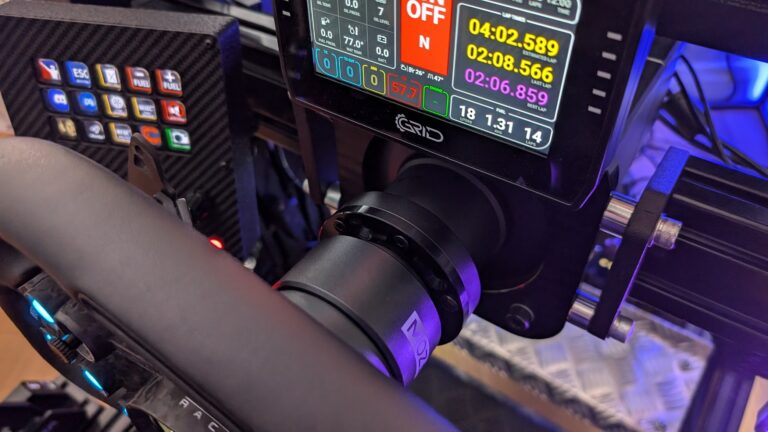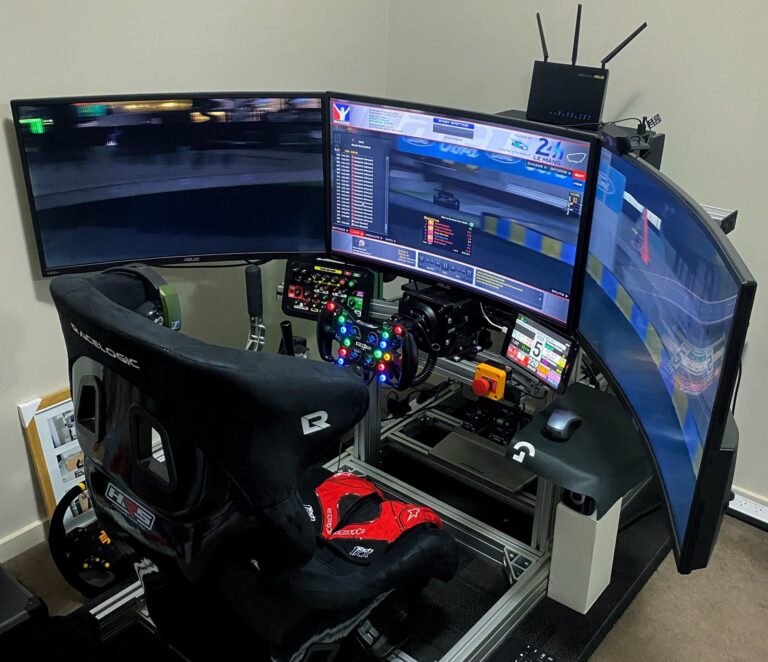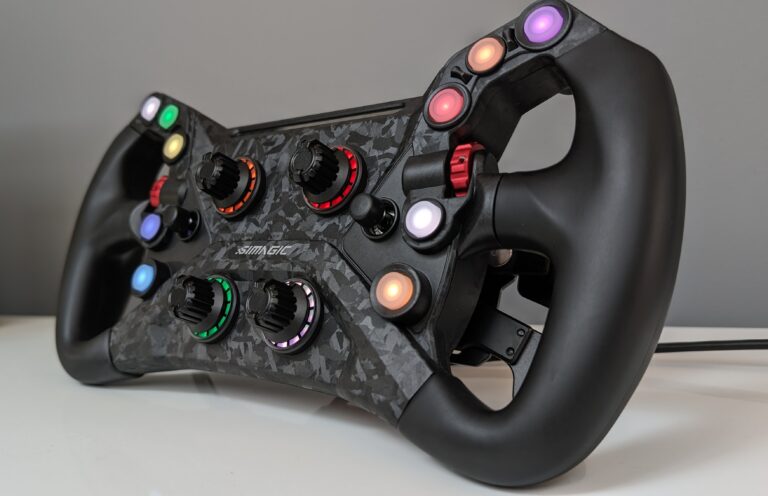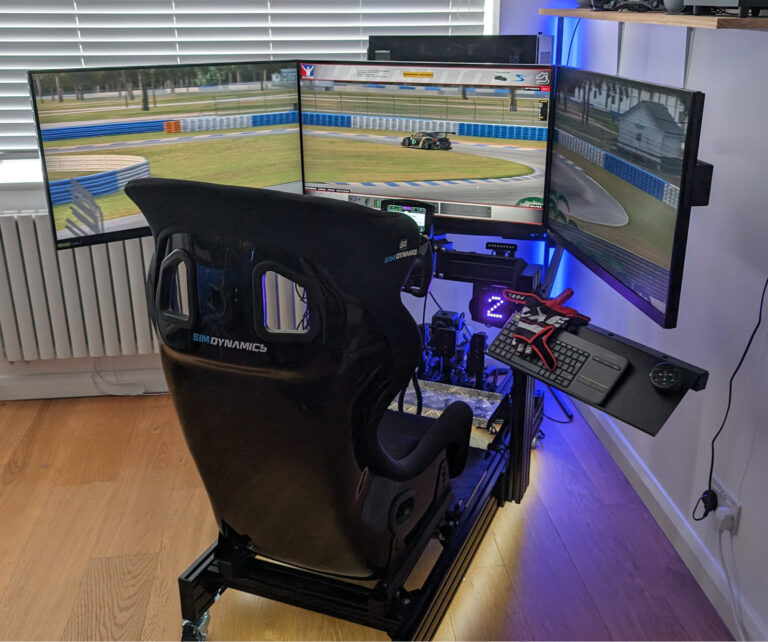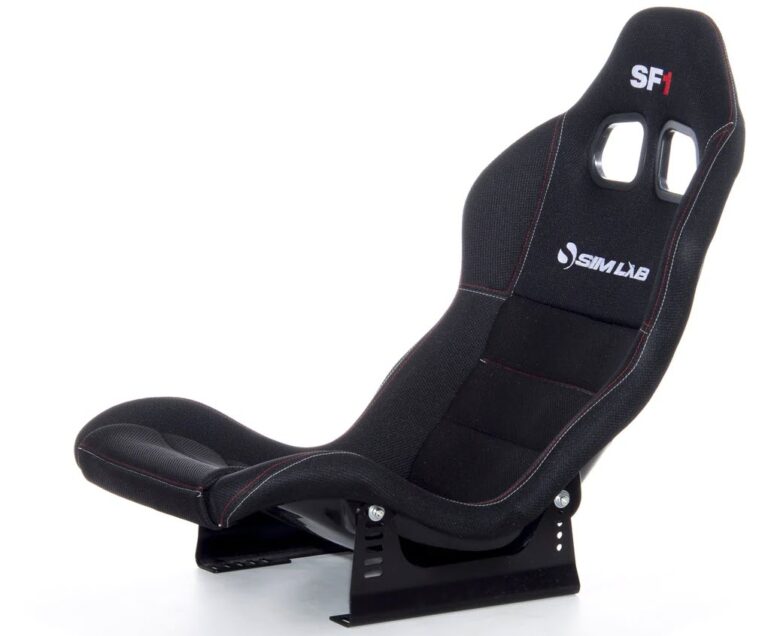Featured image: Trak Racer Large Freestanding Monitor Stand
Once you’ve chosen a good set of monitors for your sim racing rig, how are you going to mount them?
If you race at a desk, this is likely something you won’t need to think about at all, but if you have a standalone rig, you’re going to need either a single or triple monitor stand.
Sim racing monitor mounts come in several shapes and sizes, but in general, they’re designed to stand over your rig and allow you to adjust the height, spacing, and angle of your monitors.
They’re either standalone or they’ll mount directly to your rig (especially if your rig is made from 8020/40 profile).
I use a Trak Racer triple monitor mount that is bolted to the two-wheelbase uprights on my cockpit. Because the mount uses an aluminium profile, it can be adjusted to fit pretty much any cockpit that uses two vertical profile sections to mount the wheel deck. That’s every 8020 cockpit! Cockpit mounted monitor stands are somewhat height adjustable too; provided that you don’t have too many other accessories mounted (for example a PC tray can get in the way).
Regardless of mounting type, the main factor you need to consider is the monitor sizes you’re going to need to support. Very large monitors can make the side arms on a triple mount sag – on that note, check that, for your monitor size, the mount is appropriate.
Choosing the right monitor stand is going to be a decision that will vary a lot depending on your rig and room, and it’s something that I would put a reasonable amount of thought into during the planning stages.
It’s essential to make sure that whatever stand you choose can cater to the sizes of your screens. With that said, here are some great choices on the market to suit different types of setups. I’ve always preferred mounting the monitor directly onto my sim racing cockpit.
What are you looking to achieve?
There are only two variables to take into account with any monitor setup for a racing sim:
- Good triple monitor alignment
- Monitor as close as possible to driver for the best FOV

I have my G9 85cms away from my eyes, which gives enormous scope for a good FOV (field of view) despite it “only” being a 49″ monitor rather than a triple configuration.
Note that the monitor mount that came with the original rig is very simple: a few brackets and a single horizontal section of 40×40 aluminium profile. That is, surprisingly, enough to hang a G9 on (it has a special bracket that the VESA mount bolts to).
After years of tweaking monitor positions, I’ve learned that the real difference between a frustrating setup and a brilliant one often comes down to the adjustability of your mount. Whether you’re running a single ultrawide or going all-out with triples, getting the positioning spot on is crucial for both immersion and lap times.
Understanding the Two Main Types of Monitor Stands
Before diving into specific products, it’s worth understanding the fundamental difference between freestanding and cockpit-mounted solutions:
Freestanding stands sit independently on the floor or desk, separate from your rig. They’re brilliant if you need flexibility – perhaps you’re still tweaking your setup or occasionally need to move things around. The downside? They take up more floor space and can feel less integrated with your cockpit.
Cockpit-mounted stands bolt directly to your rig’s frame, creating a rock-solid, integrated setup. These are ideal if you’ve got an 8020 aluminium profile rig (which most serious setups use these days). They save space and provide unshakeable stability, but you’ll need to ensure compatibility with your specific cockpit.
Freestanding Monitor Stands
If you’re after maximum flexibility or your rig doesn’t support integrated mounting, these freestanding options from Trak Racer and Sim-Lab dominate the market – and for good reason.
Trak Racer Large Freestanding Single Monitor Stand
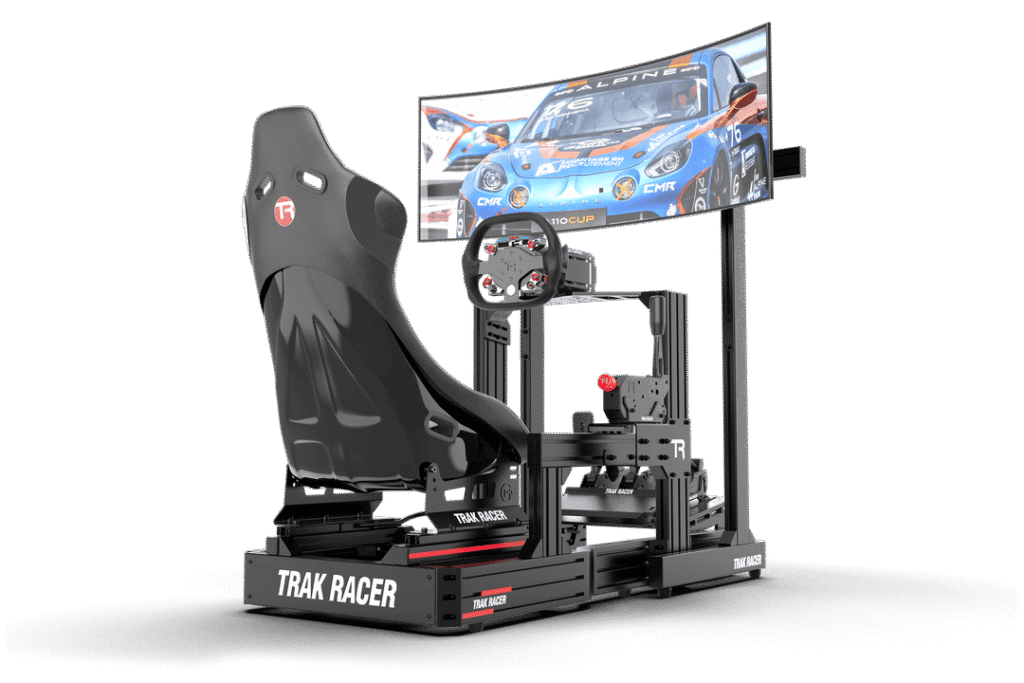
This beast can handle monitors up to 80 inches – yes, you read that right. I’ve seen this supporting massive TVs without breaking a sweat. The 1200mm wide profile means even the chunkiest ultrawides fit comfortably. At $249, it’s not cheap, but the build quality is exceptional.
Trak Racer Freestanding Triple Monitor Stand
The triple version comes in two flavours – standard ($459) supporting up to 45″ monitors, or the heavy-duty version with extra leg supports ($669) for displays up to 50″. I’ve tested both, and whilst the standard version is solid, those extra leg supports on the premium model completely eliminate any hint of sag on the side monitors.
Sim-Lab Freestanding Vario™ Monitor Mount
Sim-Lab’s Vario system is a game-changer for triple screen alignment. The patented Vario VESA adapters allow millimetre-perfect adjustments that would have you fiddling for hours with conventional mounts. If you’re the type who obsesses over perfect bezel alignment (guilty as charged), this is worth every penny.
Cockpit-Integrated Monitor Mounts
For those with compatible rigs, cockpit-mounted solutions offer the ultimate in stability and integration. These bolt directly to your rig’s uprights, creating a unified setup that feels properly engineered.
Trak Racer Entry-Level Cockpit-Mounted Single Monitor Stand
Don’t let the “entry-level” tag fool you – this 580mm wide mount handles monitors up to 60 inches with ease. It’s the sweet spot for anyone running a single screen setup who doesn’t need the extra width of the larger model. Perfect for 27-34″ monitors where you want a clean, integrated look.
Trak Racer Large Cockpit-Mounted Single Monitor Stand
The big brother offers 1200mm of width, making it ideal for those massive 49″ ultrawides that are becoming increasingly popular. I run a similar setup with my G9, and the extra width means you can position the monitor exactly where you need it without any overhang concerns.
PRO SIMRIG Single Screen Integrated Monitor Mount
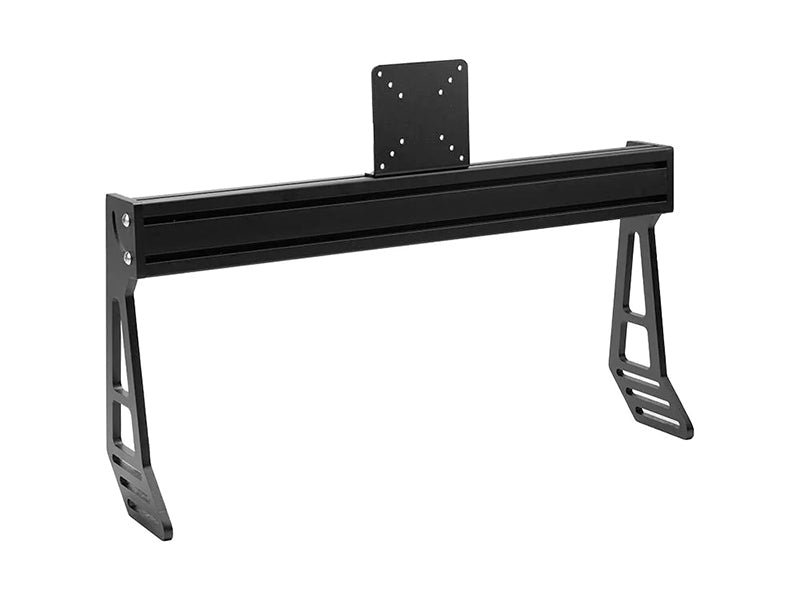
Built like a tank with 40×80 extrusion, this mount from PRO SIMRIG offers exceptional rigidity. The thick aluminium side plates mean zero flex, even with heavy displays. Available in two versions to fit different cockpit widths (650mm or 660mm between uprights), it’s a proper bit of kit for serious racers.
Sim-Lab GT1 Integrated Vario™ Monitor Mount
Designed specifically for Sim-Lab’s GT1 EVO, GT1 Pro, and P1X Pro cockpits, this integrated mount brings their brilliant Vario adjustment system to cockpit-mounted setups. The single monitor version handles ultrawides up to 49″, whilst the triple setup is optimised for 27″ displays.
I’m a huge fan of the Vario mount, and if you’re interested you can read how to set up your monitors using the Vario here.
Next Level Racing F-GT Elite Direct Monitor Mount
Specifically designed for the F-GT Elite cockpit, this carbon grey mount offers 200mm vertical and 239mm horizontal adjustment with 18 degrees of tilt. It’s one of the few mounts I’ve tested that genuinely feels premium – the anodised finish is gorgeous and the laser-aligned pre-drilled holes make installation a doddle.
Essential Mounting Accessories
Sometimes it’s the little things that make all the difference. These accessories can transform a good monitor setup into a perfect one.
Trak Racer Variable Adjustment VESA Adapter Kit
Absolute lifesaver for triple screen alignment. These adapters solved my alignment headaches when I was running triples – being able to fine-tune each monitor independently without loosening the main mounts is brilliant. Works with any VESA-compatible mount, not just Trak Racer’s own.
Sim-Lab VARIO™ VESA Adapter Kit
Sim-Lab’s patented version offers 32mm vertical adjustment, ±10mm horizontal, and ±5 degrees rotation in both planes. The engineering here is properly clever – simple hex key adjustments that stay locked in place once set.
If you’re running a non-Sim-Lab mount but want their adjustment system, this is the ticket.
4th/Top Monitor Mount Add-ons
For those running data displays or streaming setups, a fourth monitor mount above your main display is invaluable. Trak Racer offers options from $149-$159, whilst Advanced SimRacing’s version at $179.99 is built like a battleship. These typically support monitors up to 32″, perfect for telemetry or chat displays.
Sim-Lab XERO-PLAY™ Triple Pivot Adapters ($44.95)
If you’ve ever dealt with sagging side monitors on a triple setup, these are worth their weight in gold. The precision-cast aluminium adapters completely eliminate flex at the pivot points – a common weak spot in many triple monitor stands.
Quick Buyer’s Guide: What VESA Standards Mean
Before pulling the trigger on any mount, check your monitor’s VESA compatibility. Most sim racing monitors use either:
- 75x75mm or 100x100mm – Standard for monitors up to 32″
- 200x200mm – Common on larger displays and some ultrawides
- 300x300mm or 400x400mm – Big TVs and commercial displays
The good news? Most quality mounts include adapters for multiple VESA standards. Just double-check before ordering.
The Bottom Line
After testing dozens of monitor mounting solutions over the years, I can honestly say that Trak Racer’s range offers the best balance of build quality, adjustability, and value. Their domination of the market isn’t accidental – the engineering is spot on.
That said, if you’re after the ultimate in fine adjustment, Sim-Lab’s Vario system is in a league of its own. Yes, you’ll pay a premium, but for triple screen setups where perfect alignment matters, it’s worth every penny.
For single screen users, don’t overthink it – grab either the Trak Racer Entry-Level mount if you’re running anything up to 34″, or splash out on the Large version for ultrawides. Both will serve you brilliantly.
Remember, a good monitor mount isn’t just about holding your screen up – it’s about positioning it exactly where you need it for optimal FOV and immersion. The products available through our affiliate partners represent the cream of the crop, with current pricing that updates automatically. Whether you’re building your first rig or upgrading an existing setup, these mounts will see you right.



